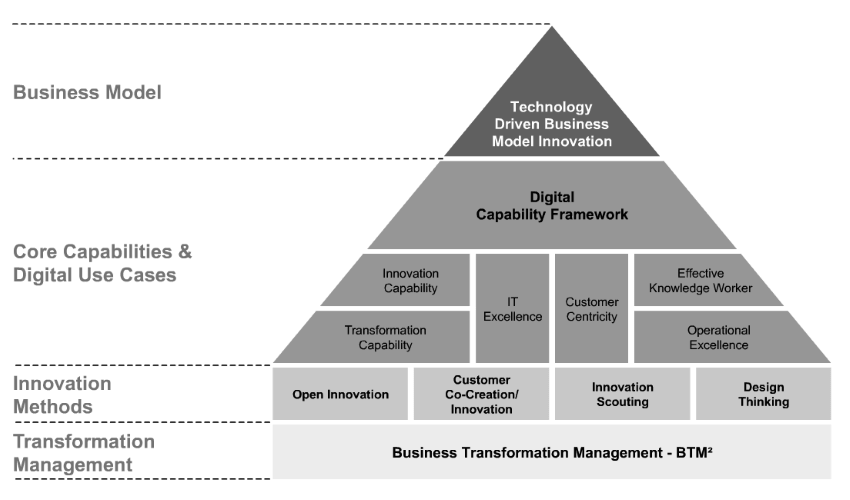Digital Business Transformation Tools

Executives striving to remain competitive in the digital economy need to invest more in digital business transformation tools and capabilities.
Digital business transformation tools are the digital economy equivalent of more traditional operational tools that have served technology and business leaders well over the last two decades. ITIL, CMMI, COBIT, TOGAF, PMBoK and others have been invaluable helping organisations adopt standards to work consistently well, and in accordance with international good practices.
But as companies accept the need to transform, and not restrict themselves to creating a better version of the past, they need to learn to leverage new tools that can help them do that.
The reality is that while most successful firms are operationally competent, not all realize that the capabilities and tools used to facilitate their operational excellence are different from the capabilities and tools required to facilitate transformational excellence.
Once leaders appreciate that the capabilities and tools that got them to where they are today, are not the same as the ones they need to get them to where they need to be tomorrow, they can begin to invest more appropriately for transformation.
The Digital Business Transformation Framework
The Digital Business Transformation Framework below can help leaders appreciate the components and capabilities they need to complement their workforce with – if they want to avoid the transformation pain that many large firms experience.

Business Models
At the tip of the framework we see ‘Business Models’, and these define who a company’s target customers are, what the organisation’s value proposition is, how the business works and why the business is financially viable. Many companies have grown on the trusty old business models that are rooted in history and bound by process and culture.
To avoid becoming irrelevant in an increasingly changing world, firms need to dust off antiquated models and make themselves fit for purpose in todays digitised environment.
The authors of “The Business Model Navigator” suggest that in the future, competition will take place between business models, and not just between products and technologies. They also explain how a company’s business model consists of four dimensions, which are:
- the customer (Who?),
- the value proposition (What?),
- the value chain (How?), and
- the profit mechanism (Why?) –
And, that a business model innovation requires significant modification of at least two of the four components.
Core Capabilities and Digital Use Cases
The second layer in the Digital Business Transformation Framework consists of ‘Core Capabilities and Digital Use Cases’. The Digital Capability Framework describes the core capabilities and digital use cases that companies need to consider if they are to approach their digital transformation holistically. Digital marketing and sales channels are the tip of the transformation iceberg, but beneath the surface are other considerations involving the workforce and operational excellence.
The Digital Capability Framework (DCF) is made up of four building blocks, which are:
- Digital Capabilities (DCF Building Block 1)
- Digital Capability Maturity Models (DCF Building Block 2)
- Digital Use Cases (DCF Building Block 3)
- Digital Transformation Roadmaps (DCF Building Block 4)
As shown below, building block 1 consists of three “Digital Enablers” and three “Digital Goals”:
Digital Enablers:
- Innovation Capability,
- Transformation Capability
- IT Excellence
Digital Goals:
- Customer Centricity
- Operational Excellence
- Effective Knowledge Worker
Innovation Methods
‘Innovation Methods’ make up the third layer in the Digital Business Transformation Framework. Implementing digital solutions without innovation rarely achieves anything transformational for a business. When innovation is lacking, transformation endeavours often serve to cut costs and introduce efficiencies. The result is ‘small change’ as opposed to ‘transformation’. This is why innovation needs to be at the heart of every company’s digital business transformation journey and should be among every leader’s digital business transformation toolset.
While many innovation methods exist, the illustration above suggests considering four fundamental innovation approaches, which include:
Open Innovation where companies use both internal and external ideas to advance technology with a willingness to consider both internal and external paths to commercialize the company’s offerings.
Customer Co-Creation enables new products and services to be enhanced through an active, creative and social collaboration process between companies and customers – superseding the Schumpeterian model where the lone entrepreneur would bring innovations to markets.
Innovation Scouting sees specialists tasked with identifying new opportunities for partnership, co-development, licensing, or acquisition. Commercially relevant technologies are more likely to be found if the scouting team comprises a combination of marketing and technical functions.
Design Thinking involves a human-centred approach to innovation that draws from the designer’s toolkit to integrate the needs of people, the possibilities of technology, and the requirements for business success (Tim Brown – IDEO).

Business Transformation Management
While innovation helps leverage new digital solutions, the planned outcomes cannot be achieved without effective business transformation management. The BBC’s failed £100 Million Digital Media Initiative is an example of how big budgets and technology expertise is useless without the right level of business transformation management capability.
The Business Transformation Management Methodology (BTM²) is the world’s first holistic and integrated approach to transformation, which is also integrated with the Digital Capability Framework introduced above. It is fundamental to any leader’s digital business transformation tools, and consists of four phases and nine transformation management disciplines.


 By
By 








